The History of Stamp Counterfeiting and How to Spot a Fake
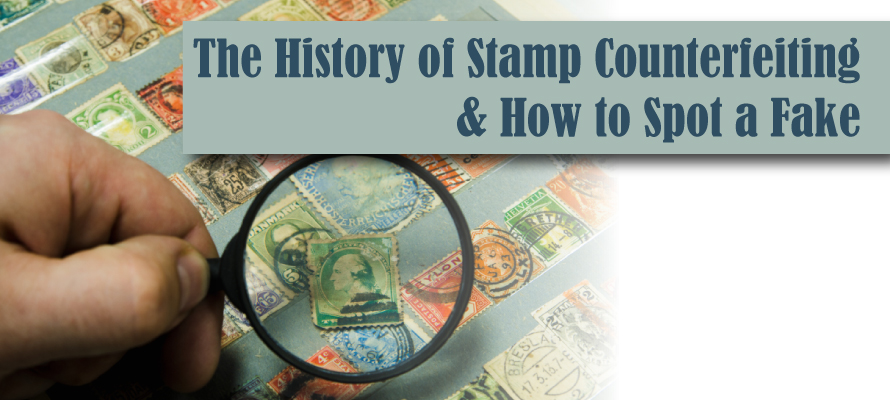
The first postage stamp was issued in Great Britain in 1840, and it didn’t take long for the first fake postage stamp to appear as well. Counterfeiting of stamps immediately became a profitable enterprise for those daring enough to try it. At first, forgers were just trying to make money off selling the counterfeit postage.
It was not until much later, when stamps became a collector’s item and people began to pay large sums of money for them, that counterfeiters started focusing on reproducing rare and valuable stamps to bilk investors. The large number of fakes has prompted postal services to implement more stringent measures to guard against forgeries, much like national mints have done for currency. A few of these steps include:
- Using special paper
- Adding watermarks
- Lining stamps with silk threads
- Employing special engraving techniques
- Reissuing different series of stamps
These techniques have helped to cut down on counterfeiting, but it has not been entirely eliminated. Interestingly, this practice has actually been adopted by some nation’s governments, who have used counterfeit stamps as a form of warfare, trying to hurt their enemies.
History may judge these nations harshly for those actions. But many people have also risen to fame, or perhaps infamy, for their bold counterfeiting schemes. Stamp counterfeiting is littered with these interesting tales. It’s important to learn them, and learn from them, to ensure collectors don’t get duped. It’s also smart to learn how to spot a fake to make sure you don’t become a part of this unseemly philatelic history.
The First Fake Stamps
The first valid postal stamp, the Penny Black, entered into service on May 6, 1840. The British citizenry embraced it. Within the next year, they mailed more than 70 million letters, and by 1843, more than 210 million letters were sent.
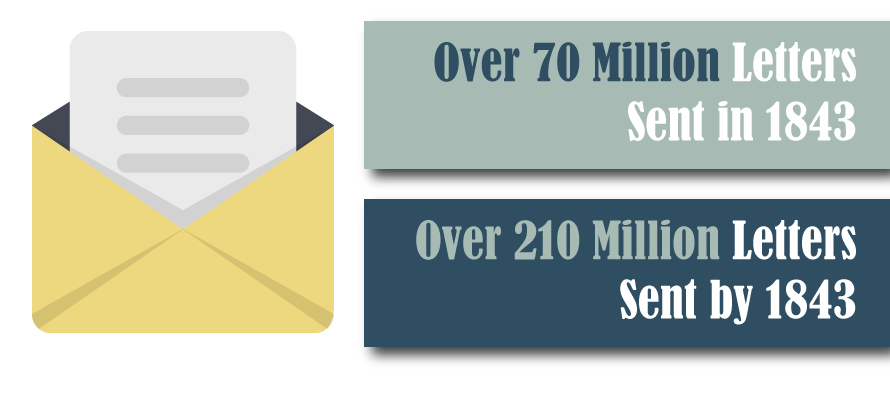
Criminals soon saw opportunity in this new form of communication. By the early 1860s, stamp forgery had become so rampant that several books had been written about it, including one by Edward Loines Pemberton, an early member of the London’s Royal Philatelic Society. Pemberton’s guide included tips on how to identifiy forgeries and descriptions of fake stamps that had been found in circulation.
Two different types of counterfeit stamps became common:
- Fakes were real stamps changed in some way. Sometimes this meant trying to remove the postmark stamp in order to use them again. As collecting became more popular, it often meant altering the stamp to resemble another, more valuable one.
- Forgeries were outright imposters. These were modeled after real stamps and made to look as much like them as possible. In the early days of stamp counterfeiting, the forged stamps weren’t very impressive, but post offices often found it hard to identify them. Forgeries became more sophisticated as the years went on.
Europe was an especially fertile ground for forgers in the early 20th century. Many of these men — it was largely a male industry — considered themselves not crooks but artists. They appreciated the detail that went into the best stamps and tried to match the technique and the artistic detail. The Italian and German forgers became particularly well-known during the first half of the 20th century. Italian forgers often worked in groups
More recently, in the 1990s and 2000s, there’s been an increase in Nigerian forgers engaging in stamp counterfeiting, though Germany is also still quite active.
Fake Stamps in the United States
The United States didn’t issue its first national stamp until 1847, seven years after the British. Within a decade, the post office got worried people were reusing stamps to send letters. But after the country became embroiled in a bloody Civil War, those concerns fell by the wayside for a few decades.
The first serious instance of counterfeiting of U.S. stamps popped up in the 1890s, when crooks in Chicago began forging stamps in an attempt to make money. These operations were mostly small scale, with locals who had experience with printing and forgery producing fraudulent stamps.
In the early 20th century, however, stamp counterfeiting in the U.S. went from small-time to organized crime. The mob saw a chance to profit and, by 1940, was heavily involved in forging stamps. Forgeries have continued on both a large and small scale since then.
The advent of the Internet, of course, opened up an entirely new realm of opportunity for stamp counterfeiters. Suddenly, they could peddle their wares to anyone anywhere, and their efforts went largely unchecked. Though sites such as eBay operate on a “buyer beware” policy, it’s become much easier for stamp counterfeiters to reach a wide audience.
The Most Infamous Forger
No discussion of the history of stamp counterfeiting would be complete without touching on the most infamous forgers, and the biggest of all was Jean de Sperati. Sperati, a native of France who was born not too long after the first stamp was issued in Britain, had a background in printing and photography. What made Sperati’s stamps so convincing was he produced them much like the post office did.
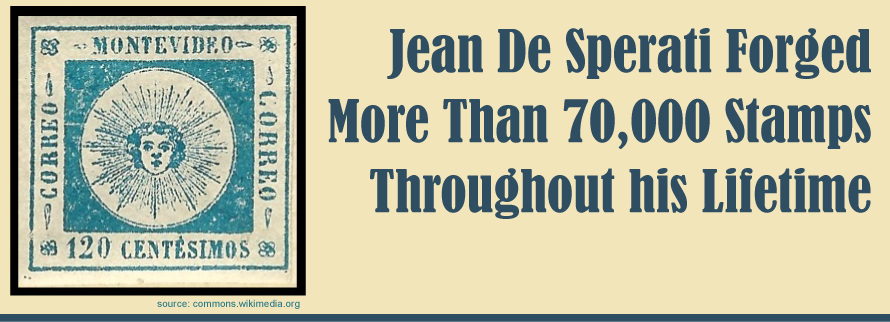
He made engraving plates that looked like the stamps he wanted to reproduce. Then he bleached other stamps so they lost their engraving and color. He used his plates to reprint over these stamps, which he felt gave them more of the look and feel of the originals. Collectors evidently agreed. Many bought Sperati’s stamps thinking they were the real thing, and to this day, not all of his forgeries have been unearthed.
Sperati was the world’s premier forger of stamps from 1910 to the early 1940s, when he was arrested for trying to ship fakes to Portugal. After being caught by the government, Sperati spent years fighting the French legal system but was ultimately convicted — not for fraud, but rather for upsetting the delicate French customs system.
Oddly, Sperati made one of his biggest sales in 1954, when the British Philatelic Association paid what was then a huge sum of money, $40,000, for his collection of stamp forgeries in order to get his tools off the market. Sperati did a lot of damage up till then. Experts believe he forged more than 560 styles of stamps, reaching across 100 countries and totaling 70,000 individual stamps.
Other Well-Known Stamp Forgers
There have been other stamp forgers, of course, though none quite so prolific or proficient as Sperati. Four others who figured prominently in stamp counterfeiting history are:
- François Fournier: Probably the best-known forger aside from Sperati, Fournier made a proper business out of his gift for reproducing stamps. He openly sold his fakes, admitting they were just imitations of the real thing. Collectors sought him out in the late 1800s and early 1900s to fill gaps in their collections for a low price, but the problem came when others resold Fournier’s works claiming they were originals.
- Madame Joseph: This British forger, who operated between World Wars I and II, specialized in fake cancels she sold to dishonest stamp collectors. They could then make fake but perfectly placed cancels on their unused stamps, upping their value. As recently as 1990, the Royal Philaletic Society of London was still trying to protect its members from her fakes.
- Dr. Peter Winter: A German opera singer, he created a huge uproar in the late 1990s when he claimed to have discovered a second British Guiana 1c Magenta, one of the world’s rarest and most valuable stamps. However, the Royal Philatelic Society of London identified the second stamp as a fraud. Winter has made many other forgeries, too, specializing in replicas of the world’s most highly valued stamps.
- Harold Treherne: Treherne was just 18 years old when he got into the business. During his work as a clerk, he figured out how to make forgeries using just black ink, a much simpler technique than most of his contemporaries in the early 1900s. Treherne later moved on to making overprints of Indian stamps, but his career was short-lived. Five years after he began, Treherne was arrested and eventually sentenced to four months of hard labor for his fraudulent crime.
Famous Cases of Counterfeit Stamps
Winter’s fake British Guiana 1c Magenta may be the most audacious example of stamp fraud, because the stamp being forged was of such great value. But there have been other famous cases over the years.
In fact, one of the very first forgeries was perpetrated by the British postal service. In 1856, it commissioned counterfeits of its 1d stamps, just to see if its stamps were capable of being copied. The unfortunate news: They were.
Later on, in the mid- to late-1800s in Hamburg, the printing firm Spiro Brothers produced some 500 reproductions. They weren’t intended to deceive collectors, however. Spiro Brothers made no secret of the fact that they were forging stamps, which were meant to fill space in collections. However, over the years, the stamps were distributed so widely that people lost track of the fact that they were fakes and began treating them as the real thing. They still pop up in collections today.
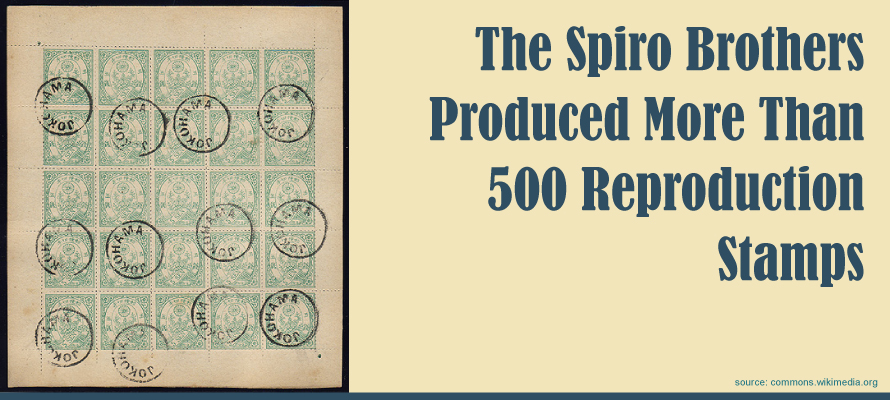
At the turn of the 20th century, Belgian Dr. Lucian Smeets was forging stamps. Those he’s believed to have counterfeited include the British Victorian stamp, which is still held up today as an example of a well-executed fake watermark.
By 1962, authorities learned that a lot that was supposed to include classic Mexican stamps instead consisted largely of forgeries by well-known forger Raoul Charles de Thuin, a Belgium native who became a Mexican citizen.
Another more recent example involves a sports victory. England’s soccer team won the World Cup in 1966. The British public couldn’t get enough of its victorious squad, so the British postmaster ordered the production of a commemorative stamp for the occasion. People went nuts. Lines formed outside of post offices to get the stamps, and the government did not produce nearly enough to meet the demand. That led to copies of the stamp being sold on the black market for many times their original value.
Other famous stamps that have been subject to counterfeiting include:
- A Liberty Bell stamp from 1980 in the U.S.
- A depiction of the Sydney Harbor Bridge from 1932 in Australia
- Germany’s 10pf from 1902 and 1909
The Odd Case of Government Stamp Forgeries
Individuals aren’t the only ones who engage in counterfeiting. One of the strangest, but also most interesting, aspects of stamp counterfeiting is the large number of governments that have engaged in the practice.
Their motives, of course, are very different from those behind the average stamp forgeries. Governments have used stamp forgery to essentially throw a wrench into a rival country’s mechanisms. Counterfeit stamps can cost a country revenue, because its citizens pay for the fakes rather than the real ones, diverting money from the government.
Fakes can also be used to distribute propaganda. For instance, a message can be printed on the stamps that undermines the messages being sent by the government. Perhaps the best example of this came in World War II, when the United States made postage stamps to attach to letters dropped into Germany. The stamps included an inscription that translated roughly to “the Reich has been ruined,” and they caused great confusion and consternation among the German people.
Collections of Forgeries
Forgeries are an important part of stamp collecting history, so it’s little wonder many collectors have become fascinated by them. A few high-profile collections even focus on stamp forgery. These include:
- The Turner Collection of Forgeries at the British Library Philatelic Collections
- Scottish Philatelic Society’s reference collection of forgeries
- National Postal Museum Library Collections at the Smithsonian Institution
Protecting Yourself From Stamp Forgeries
You may be spooked after reading the history of stamp counterfeiting. Don’t be. For one thing, fraud is not as common now as it was 100 years ago, largely due to technology. It’s easier now to identify forged stamps.
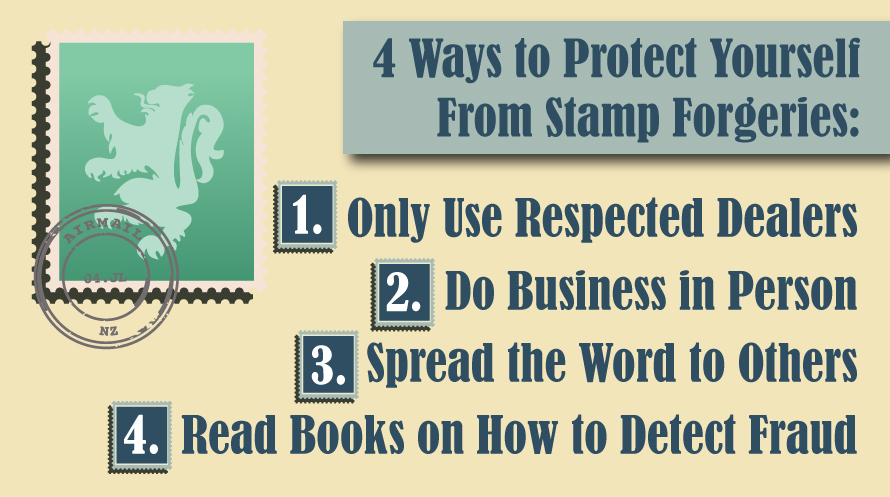
But you still need to protect yourself against stamp forgeries. Here are four ways to do it:
- Only use respected dealers. Keep your business dealings with people you know and trust. Ask other collectors for references if need be.
- Do business in person. Though the Internet is certainly convenient, you never know who you are dealing with. If someone refuses to meet you in person, there’s generally a reason.
- Spread the word to others. Whether you had a bad or good experience with a dealer, talk about it with your buddies. That way you warn others off of a bad dealer.
- Read books on how to detect fraud. The more informed you are, the harder you are to dupe.
Don’t Be Stumped by Bad Stamps: Stamp Authentication
It’s clear stamp counterfeiting has been and remains a big business, despite modern technology that can detect fake stamps better than ever before. So what’s a stamp collector to do? The best defense is a good offense. That is, collectors are best served by investing in stamp authentication to spot a fake before blowing lots of money.
The American Philatelic Expertizing Service offers stamp authentication, which employs more than 120 experts to figure out the value and validity of a stamp. Of course, this comes at a price, so some people prefer to do most of the leg work on their own whenever possible.
Warning Signs: How to Spot Authentic Stamps
It’s useful to know what to look for in stamps in order to determine if they’re authentic. If you see any of these warning signs of a fake, you should walk away immediately:
- Watermarks: Difficult to reproduce, watermarks differ by country and act as a “stamp” of approval from the issuing country’s postal service. Check the Scott Catalogue against your stamp to see if the watermark looks correct.
- False postmarks: Examine the cancel mark carefully. This is one of the key signs of fraud.
- Regumming: Having the original gum is very valuable, and forgers know that. They try to “regum” stamp backs to make it look as though they are originals. The surface of a regummed stamp will be dull and have minor inconsistencies you don’t see on original gum.
- Perforation: The perforation around a stamp may be modified or removed in order to enhance its value. Remember that most stamps are gummed first and then perforated, so look for signs that this did not happen in the right order.
- Quality: Though there have been a handful of gifted forgers, most are not nearly diligent enough to achieve the fine attention to detail that defines a high-quality stamp. You can often tell just by looking at a stamp that the quality is too low to be legitimate.
Have Confidence in Your Next Purchase
To avoid counterfeit stamps, go with a dealer you can trust. Apfelbaum, Inc. has hundreds of authenticated stamps for you to shop. Contact us today to help grow your collection. Interested in selling you stamp collection? Contact us for our experience and expertise in the sale of your stamp collection.
